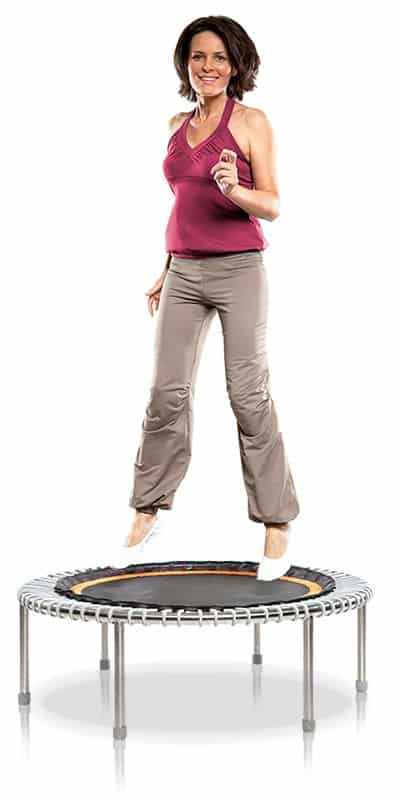Trampoline vs. Jump Rope
Considering jump rope and using a trampoline involve the same basic movement, it can be difficult to tell which is better.
This is particularly true if you’re at the beginning of your fitness journey and you want to know the best exercises for your goals. If you are at the beginning you might be weighing up different equipment such as a mini trampoline also known as a rebounder or a jump rope.
So, in this article, we’ll look at using a trampoline vs. jump rope. We’ll discuss which is better, and why, before going over some exercises and how to get the most from each piece of equipment.
Ready to start your rebounder weight loss journey? Try out our 8-week rebounder program!

Is Rebounding Like Jump Rope?
At the most basic level, rebounding is much like jump rope. This is because both exercises involve jumping. However, there is a fundamental difference between them related to how you jump.
When jump rope, the basic exercise is jumping up over the rope, repeating for a set time. Here, the emphasis is on launching your body into the air, which works muscles in your legs.
With rebounding, however, the emphasis is more on the downward movement. You don’t want to spend much time in the air on a rebounder, as this doesn’t do much in terms of burning calories or working your muscles.
The same is true for a large trampoline, although you’ll probably find high-intensity, jogging-style workouts easier on a rebounder. That said, a trampoline can still provide fun exercises.

Is Rebounding Better than Jump Rope?
Although it depends on your definition of better, rebounding is probably an all-round better exercise than jump rope. Both provide decent cardio exercise and calorie burning, but there are some distinct differences that matter when thinking about your overall wellness.
Benefits of Rebounding
The biggest thing about rebounding is that it’s a low-impact exercise. Your feet never make contact with the ground, meaning your joints aren’t put under stress every time you complete a jump.
Importantly, this makes rebounding much healthier for your joints. While you might not notice any problems when you’re young, repeatedly doing high-impact exercises can come back to haunt you in old age!
Another big benefit of rebounding is that it doesn’t take much skill. You get on the trampoline and jump – that’s the basics of it. You can get models with handlebars for support, particularly as you become familiar with the correct movement.
Finally, it’s easy to mix up your exercise routine with a rebounder. You can do all kinds of stretches and jumps for an interesting and varied workout routine. Of course, it’s worth mastering the basics before you look at anything too technical.
Drawbacks of Rebounding
The main drawback of rebounding is probably the price. Granted, an entry-level rebounder isn’t super expensive, but the pro models can cost hundreds for better materials and a longer lifespan. Regardless of the price you pay for a rebounder, it’s always going to be more than a skipping rope.
The second drawback is the required space. Again, a rebounder isn’t massive, but it takes up a lot more room than a skipping rope. You can get folding rebounders, which help with storage. But unless you can find one that folds up smaller than a 7ft. rope, rebounders are always going to lose.
Benefits of Jump Rope
The main thing to say about jump rope is that it burns a surprising amount of calories. A 15-minute jump workout could burn between 200 and 300 calories, which is 25% more than running.
While it’s not a benefit compared to rebounding, it’s worth mentioning that jump rope is a stationary activity. Considering it burns more calories than running, this is another big benefit.
Also, jump rope is far more affordable than rebounding. If you really wanted to get into jump rope, you could theoretically do it for free by picking up any old piece of rope you see lying around. From a beginner’s perspective, this is a great help.
Due to it being a high-impact exercise, jump rope can actually improve bone density. One study found that jump rope improved bone density in the legs and hips. However, it was conducted on school-age girls, so isn’t massively relevant for adults.

Jump rope can make a big difference to your overall coordination. It’s what’s known as a plyometric exercise because it uses fast speeds and force to build muscle. Importantly, it forces you to coordinate your balance and basic motor skills to achieve a good workout. While rebounding also does this, jump rope is arguably more difficult.
Drawbacks of Jump Rope
And that brings us to the drawbacks of jump rope. It can be surprisingly difficult to get into jump rope because it does involve such coordination. If you haven’t exercised in a long time, getting your body to do what you want can seem challenging.
It’s also worth mentioning again that jump rope is a high-impact exercise. In short, this causes stress to your joints as your feet make contact with the floor. Considering you do this a lot when jump rope, it can make a considerable difference to the overall health benefits of the exercise.
While this might not be a massive concern for kids and younger adults, it should certainly be a consideration for older adults and seniors. As you age, your bone density changes and the cartilage in joints (such as your knees) wears away. Performing high-impact exercises can therefore increase the risk of injury.
Trampoline vs. Jump Rope: Which is Right for Me?
The bottom line is that, in most situations, buying a rebounder is probably the better choice. The extra calories burnt by jump rope are arguably negated by the impact it has on your joints. However, there are some cases where jump rope might be better:
· You’re young and can tolerate the impact on your joints.
· You don’t have the space to store or use a rebounder.
· You can’t afford a rebounder.
While skipping rope exercises aren’t as varied as rebounder exercises, if it’s the difference between working out and not, jump rope is certainly worth trying.
Rebounding Exercises
There are so many ways to add rebounding into your exercise routine. In fact, you could do most of your workout on the rebounder itself by adding in weights. Here are some suggestions for beginner level rebounder exercises.
Jogging
Rebounding is essentially jogging on a bouncy platform, so it’s worth getting the basics right. You basically need to jog as normal with a bit more emphasis on the downward push of your legs. Raise your knees a few inches until you’re familiar with the process. After that, you can lift your knees higher.
Your arms should pump as they would when you jog normally. Consider holding weights for a bit more resistance.
Jumping Jacks
To do jumping jacks on a rebounder, get a good basic bounce going. From there, alternate between landing with your legs together and your legs apart. When you bounce with your legs apart, swing your arms above your head so your hands touch.
As with jogging, make sure you stomp down on the rebounder on the downward movement. It can take a while to get used to this, as it’s quite different from walking and jumping normally.
Jumping Squat
Once you’ve mastered jumping, why not throw in some squats, too? Begin by bouncing with your feet apart. Every other bounce, lower your body so your hips pass your knees. Think how you’d do a normal squat and alter your stance slightly to accommodate being on a rebounder.
Hold it for a second or two before rising again. Like normal squats, this action helps strengthen your legs, glutes, and hips.
Rebounder Push-ups
You can use a rebounder for all kinds of push-up variations. The simplest is to use the rebounder as a surface for incline push-ups. Either hold onto it and extend your legs behind you or put your feet on the rebounder and your hands on the floor. Granted, you’re not technically using the rebounder for its intended purpose, but it’s a useful stable surface.
Alternatively, you could do bouncing push-ups. Simply put your hands in the centre of the rebounder and your feet extended behind you. Use the rebounder to bounce up, landing with your hands close together. Switch bounces between hands close together and far apart.
Jump Rope on a Trampoline
If you’re feeling really adventurous, consider using a jump rope on a trampoline. For this, you’ll want to use a full-size trampoline because doing it on a rebounder will be a bit dangerous.
All you need to do is jump rope as normal but factor in the extra bounce time from the trampoline. It can feel a bit strange at first, but if you know how to jump on a trampoline and use a skipping rope, you’re most of the way there.
Jump Rope vs Trampoline – The Final Verdict
While using a jump rope vs. trampoline both offer health benefits, there are some clear differences. Rebounding or trampolining is arguably better for your joints, but jump rope offers a more intense workout. Which you choose ultimately depends on your goals, but at least you can now make an informed decision.
An ex-triathlete, fitness coach and writer with a Masters in Sports Physiology. Fitness is my passion and I've had my fair share of home fitness equipment tried and tested!



One Comment